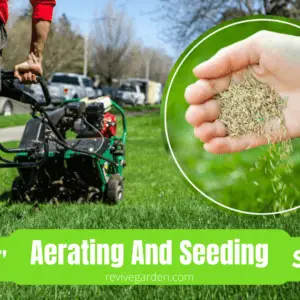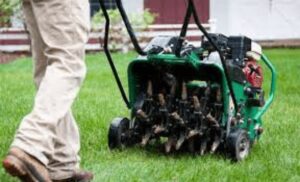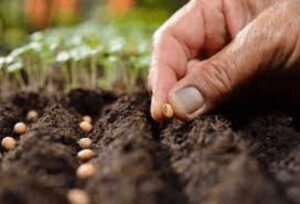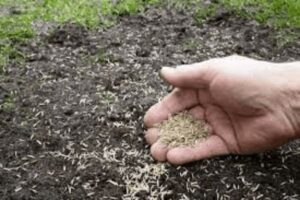Table of Contents

Grass has its own life cycle, just like a tree or any other plant. It goes through growth phases and sometimes death phases; there will be no harm to your lawn if you aerate and seed it properly. These are two separate processes to ensure that your lawn is properly maintained.
However, when you add aeration into your maintenance routine, you’ll see an increase in the health of the grass. The purpose of aerating and seeding is to provide for proper growth, establish healthy roots, and improve lawn density.
This article will help you to understand the importance, benefits, and uses of aeration and seeding.
You may like to visit our other article about whether should I kill weeds before overseeding or not.
What Is An Aeration?
Aeration is the process of pushing air through the soil. This improves drainage and allows the roots of plants to grow deeper – giving them better access to nutrients like water and minerals. Sowing grass seed in well-drained soil requires a good aeration system. A properly aerated soil can be more advantageous for growing grass in them.

Why Is Aeration Important?
It makes sense to fertilize and aerate simultaneously, as both contribute to lush grass. Aerating a lawn is a simple way to ensure that the soil below the grass receives adequate amounts of water, air, and nutrients and is not stifled by a dense layer of thatch or compacted soil. Regular foot traffic can compact soil, making annual aeration of heavily utilized lawns necessary. A core aerator is used for this purpose; it extracts small cores of dirt and thatch.
What Is An Overseeding?
Overseeding is planting grass seed in an established lawn without removing the current grass or aerating the soil. Overseeding is a technique used by lawn care professionals to make green grass greener.

Why Is Overseeding Important?
Even if your yard already grows grass, “re-seeding” or “overseeding” is standard practice for maintaining a lush and green lawn. It can remedy the weak spots in the grass caused by weeds, heat stress, pests, and disease by scattering extra seeds over the entire region. Overseeding with a variety of origins is essential. That’s a collection of fescue seeds with varying degrees of drought tolerance, disease resistance, and heat tolerance. In addition, be sure there are no hazardous weeds or weeds of any kind listed on the seed’s package.
How To Aerate And Seed Your Lawn?
Aerating and seeding your lawn in spring is beneficial to improve your grass’s health, density, and overall appearance. Here’s a step-by-step explanation of the process:
- Assessment: Before starting, assess your lawn’s condition. Look for areas with thin or patchy grass, compacted soil, or areas prone to erosion. Identifying these issues will help you target the right areas during aerating and seeding.
- Choose the right time: Spring is an excellent time for aerating and seeding because the soil is usually moist, temperatures are moderate, and grass growth is naturally active.
- Lawn Mowing: Begin by mowing your lawn to a shorter length than usual, about 2 inches (5 cm) or so. The shorter grass allows for better seed-to-soil contact during seeding.
- Aerating the lawn involves perforating the soil with small holes to allow better air, water, and nutrient penetration to the grassroots. This reduces soil compaction and encourages healthier root growth. You can use a manual or mechanical aerator for this task. Mechanical aerators are usually more efficient for larger lawns.
- Seed selection: Choose high-quality grass seed matching your lawn’s existing grass type or a seed blend that suits your region’s climate and sunlight conditions. If you need more clarification, consult with a local lawn care expert.
- Seeding the lawn: Evenly spread the grass seed over the entire lawn, paying extra attention to thin or bare spots. You can do this by hand or using a spreader for more precise distribution.
- Topdressing (optional): For better seed germination and to protect the seeds from birds, you can consider applying a thin layer of compost or topsoil over the seeded areas.
- Watering: After seeding, water the lawn thoroughly but gently. You want to keep the soil consistently moist to encourage seed germination. Avoid overwatering, as it may lead to fungal issues. Continue watering regularly until the new grass establishes itself.
- Post-care: Once the new grass starts growing, avoid heavy foot traffic on the seeded areas for a few weeks to allow the grass to strengthen its root system.
- Fertilizing: After the new grass has grown to a sufficient height (usually after the first mowing), you can apply a balanced fertilizer to provide essential nutrients for healthy growth.
- Regular maintenance: To ensure the success of your newly seeded lawn, maintain regular lawn care practices such as mowing at the appropriate height, watering as needed, and addressing any weed issues promptly.
Difference Between Seasonal Aerating And Seeding – Spring Or Fall
While spring and fall are suitable times for aerating and seeding, there are differences in the outcomes and considerations for each season. Here’s a comparison chart highlighting the main distinctions:
| Aspect | Aerating and Seeding in Spring | Aerating and Seeding in Fall |
| Timing | Spring (typically between March and May) | Fall (typically between August and October) |
| Grass Growth | Grass growth is naturally active in spring. | Grass growth slows down, but roots remain active in fall. |
| Seed Germination | Soil temperatures are warming, aiding germination. | Soil temperatures are cooling, but still favorable. |
| Weather | Moderate temperatures and rainfall support growth. | Cooler temperatures reduce stress on young seedlings. |
| Weed Competition | Weeds can be more aggressive in spring. | Weed competition is lower in fall. |
| Lawn Recovery | Helps the lawn recover from winter stress. | Allows the lawn to recover from summer stress. |
| Best for Repairing | Best for repairing damage from winter conditions. | Best for repairing damage from summer heat and stress. |
| Overseeding | Suitable for overseeding and thickening the lawn. | Excellent for overseeding and filling in bare patches. |
| Preparation | Requires adequate moisture management in spring. | Less concern for excessive moisture in fall. |
| Fertilization | Fertilize after seeding when the grass starts growing. | Fertilize before seeding to support germination. |
The suitability of spring or fall for aerating and seeding may vary depending on your location and local climate conditions. Some regions may have particularly harsh winters or hot summers, influencing the optimal timing for these lawn care practices. Always consider your local conditions and the specific needs of your lawn before deciding when to aerate and seed.
Benefits Of Aerating And Overseeding Your Lawn
Germination must occur weeks before the first Roots of grasses struggle in a dry, hot summer to hold on to water and nutrients, putting the whole plant under stress. The dirt gets compacted and splits in numerous locations due to the summer’s intense dryness.
Many lawns go dormant and yellow under these circumstances. A protracted drought also causes a wide variety of other problems for properties. Warm-season weeds, pests, and diseases can spread quickly and ruin an otherwise healthy lawn. Aerating and overseeding your grass is something we think you should seriously consider. Here are eight ways in which these restoration services will improve your grass:
- Soil compaction is decreased by aeration. The same way that you wouldn’t try to grow a flower in a cement pot… A lawn planted in a bed of hard soil will not thrive. Grassroots can reach deeper into loose soil in drought, increasing their chances of finding the water they need to survive.
- Thatch is diminished by aeration. Grass thatch forms when grass stems, and roots collect faster than decompose. Pests and diseases thrive in areas with high levels of thatch.
- Root zone access is improved by aeration. Water, air, and other beneficial nutrients can be absorbed by a plant’s roots only if they reach the root zone, achieved when the soil is broken up.

- As a result of increased airflow, seed germination rates improve. It’s not hard for seeds to sprout in aerator holes since the holes give them a haven.
- New grass seed is introduced to thicken existing turf and fill in barren or thin areas. Grass plants eventually mature and die, at which point It must replace them. Damage to the grass can come from various sources, such as pets’ excrement, people walking barefoot on it, extreme temperatures, a lack of water, and other environmental problems.
- Overseeding increases hardiness against illness. Grass diseases that can destroy a whole lawn can be mitigated by using a variety of grass seed mixtures.
- You can reduce weeds through aeration and overseeding. Weeds that are opportunistic seedlings only appear in favorable environments. Weeds like crabgrass and nutsedge thrive in sparsely vegetated areas, whereas broadleaf weeds spread in low-lying and shady locations. A thick lawn is an excellent protection mechanism.
- You may instantly enhance the existing look of your lawn by doing aeration and overseeding. Core aeration and overseeding will help revive a property damaged by pests, disease, or animals. In 7–10 days, you should see the seeds sprout.
When Should I Aerate And Seed My Lawn?
Aeration and seeding are best done in the late summer or early fall. Aeration and seeding are more likely to be successful in cooler weather since the turf will remain damp for longer after being irrigated or when it rains.
The best time to overseed for cool-season grasses like tall fescue and Kentucky bluegrass is in the fall, whereas for warm-season grasses like Bermuda grass and zoysiagrass, it is in the spring or summer. A lush lawn is the consequence of careful timing of aeration. Each year in early spring is an excellent time to evaluate your lawn care requirements.
Thus it’s essential to get the seeding done as soon as possible. Due to these factors, aerating and seeding should be performed at the end of summer or the beginning of fall. The service may be successful for a short period in the spring, but it is usually not worth the effort because of the many factors that could harm its quality if performed.
How Much Aeration And Seeding Cost?
The cost of aerating and seeding your lawn can vary depending on several factors, including the size of your lawn, the region you’re in, the professional you hire, and any additional services you may need. Below is an estimated cost chart to give you an idea of the potential expenses involved:
| Lawn Size | Aerating Cost | Seeding Cost | Combined Cost |
| Small (1,000 sq ft) | $50 – $100 | $50 – $100 | $100 – $200 |
| Medium (5,000 sq ft) | $100 – $200 | $100 – $200 | $200 – $400 |
| Large (10,000 sq ft) | $200 – $400 | $200 – $400 | $400 – $800 |
| Very Large (> 1 acre) | $400 – $800+ | $400 – $800+ | $800 – $1600+ |
| Keep in mind that these are rough estimates, and actual costs may vary. Additionally, some lawn care companies may offer bundled packages that could reduce the overall cost when combining aerating and seeding services. |
Also, read our guide about Overseeding with Bermuda.
EndNote
Aerating your lawn helps improve your grass’s health and growth by increasing the flow of oxygen to the roots; also, by adding seeds, you’re giving the soil structure and a medium for new growth. Aerating and seeding your lawn is a fantastic way to make it healthy.
This article presented the definition and importance of aerating and seeding process, its benefits, and a guide for when and how to perform the process. If you want to Aerate and seed your lawn, then this article will help you.
